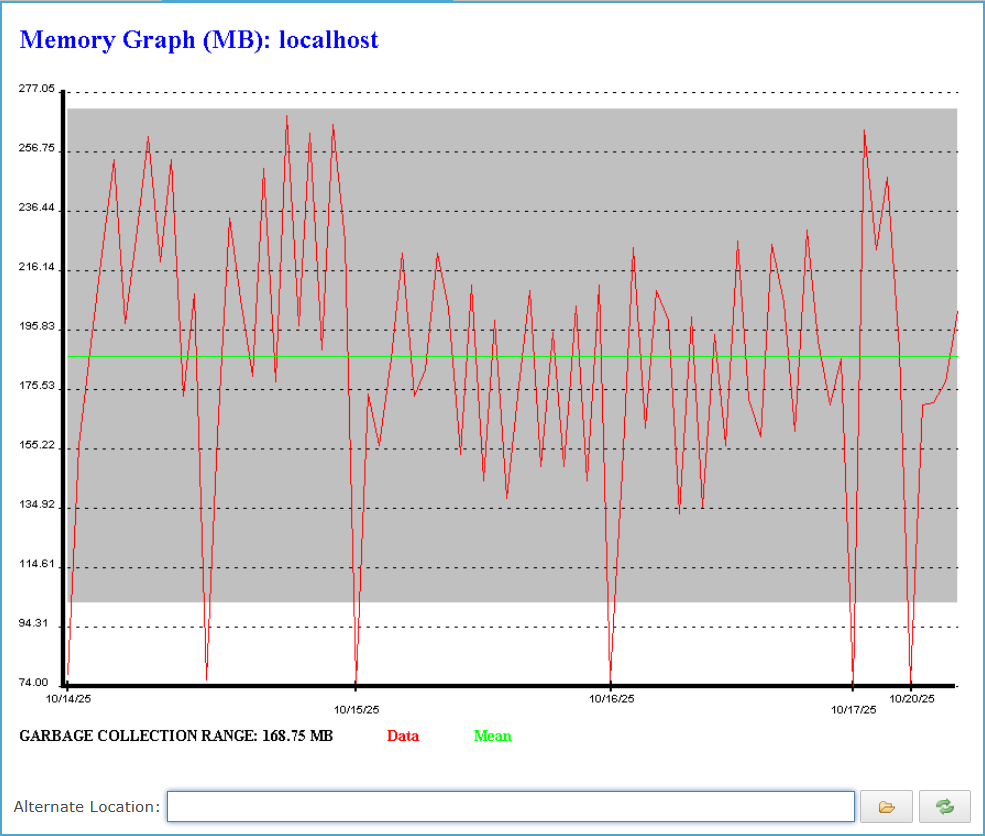 EM: BBj Services > Memory Usage
EM: BBj Services > Memory Usage
Description
The  Memory Usage page provides real-time graphical monitoring of BBjServices memory allocation and garbage collection activity. Clicking the
Memory Usage page provides real-time graphical monitoring of BBjServices memory allocation and garbage collection activity. Clicking the  button retrieves current data and update the memory usage graph, displaying active memory consumption trends, mean usage, and garbage collection range in megabytes.
button retrieves current data and update the memory usage graph, displaying active memory consumption trends, mean usage, and garbage collection range in megabytes.
Location
![]() EM Navigator →
EM Navigator →  BBjServices →
BBjServices →  Memory Usage
Memory Usage
Toolbar
| Button | Function |
|---|---|
|
Refreshes the page, and displays the Memory Graph chart. |
|
|
Deletes a selected directory. |
|

|
Allows the selection of file(s). |

|
Allows to create new file/folder. |

Memory Graph(MB)
Displays the graphical view of BBjServices memory performance on localhost, showing real-time Data, GARBAGE COLLECTION RANGE, and Mean memory consumption to evaluate resource stability and performance consistency.
Memory Graph(MB) Settings
| Settings | Description |
|---|---|
| GARBAGE COLLECTION RANGE | Indicates the total memory reclaimed during garbage collection, reflecting system efficiency in freeing unused resources. |
| Data | Real-time memory usage pattern of BBjServices, helping users monitor current memory activity and identify variations during system operation. |
| Mean | Calculated average of all recorded memory readings, providing users with a consistent baseline for analyzing BBjServices performance trends. |
Memory Graph(MB): Alternate Location
The Alternate Location field allows users to define a custom directory path for storing or accessing BBjServices data, configurations, or generated reports. Selecting the  icon opens the Browse for Folder dialog, enabling navigation to the desired location or the creation of a new folder by clicking the
icon opens the Browse for Folder dialog, enabling navigation to the desired location or the creation of a new folder by clicking the  icon. This feature ensures flexibility for administrators to redirect output or data storage locations according to their deployment structure, maintaining organized system management across varied environments.
icon. This feature ensures flexibility for administrators to redirect output or data storage locations according to their deployment structure, maintaining organized system management across varied environments.
Java Memory Management
Java memory management continues to provide new and interesting challenges for BBj deployment. To simplify the memory management process, BASIS has added a BBjServices memory graphing function in The Enterprise Manager. This memory-graphing tool parses the BBjServices.out log files and plots the amount of used memory recorded in the files every time a BBj interpreter starts. The best way to use this graph is to view it after BBjServices records several hundred connections. As an opportunistic memory consumer, Java eventually uses as much memory as the administrator allows when the java -Xmx command line parameter is set. By default, the JVM uses 64 MB of memory. Therefore, if BBj runs out of memory, the administrator must increase the -Xmx parameter until BBj runs without generating "out of memory" errors. As the administrator increases the -Xmx value, it is important that the system have enough unused physical memory to accommodate the -Xmx value of the JVM, preventing the OS from swapping out the Java memory to the swap file on the disk.
Once BBjServices have enough memory, it is time to start using the memory-graphing tool. Now that BBj has enough memory to run the applications in a production environment, it is possible to begin tuning the amount of memory allocated to the JVM. After hundreds of connections, the memory-graphing tool reveals the garbage collection patterns in the JVM. The pattern is typically saw tooth, which is caused by the JVM's internal garbage collector.
During the normal running of BBjServices, the JVM continuously consumes more memory than the "incremental" garbage collector can free. Once the JVM approaches the upper bound of the -Xmx value, it suspends the running processes, does a full garbage collection, and frees all of the memory not consumed by the running processes. As long as the "full" garbage collection frees 40 to 50 megabytes of memory, users usually do not notice when a full garbage collection occurs. However, if the full garbage collection frees more memory than this, the end users experience application pauses. To provide better performance for the end users, reduce the -Xmx value until the full garbage collections free only 40 to 50 megabytes of memory.
Remember that the changes to the -Xmx value take effect only after restarting BBjServices. The graphing function in the Enterprise Manager automatically applies a standard deviation function that bands the average full garbage collection delta to simplify the tuning procedures. In the past, many releases of the JVM included different garbage collection algorithms, so it is important to monitor the used memory graph after introducing a new JVM in production.
See Also